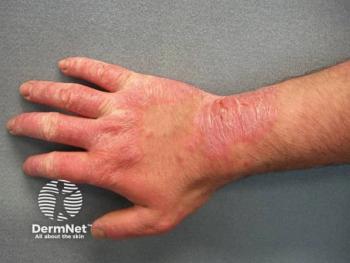
Understanding the Role of OX40 in Next-Generation Eczema Therapies

Acting upstream of cytokines may hold the key to improving biologic efficacy and itch relief in AD.
In a recent interview with Dermatology Times, Christopher Bunick, MD, PhD, associate professor of dermatology and translational biomedicine at Yale University School of Medicine, shared insights into the evolving science of biologics for atopic dermatitis (AD)—specifically, the emerging therapeutic potential of targeting the OX40/OX40 ligand pathway.
According to Bunick, a critical limitation of current biologic therapies lies in their "monotargeted" approach. These agents typically inhibit individual cytokines involved in the pathogenesis of AD, such as IL-4, IL-13, or IL-31. While effective for many, they may not fully address the complex and heterogeneous immunologic profile of the disease in all patients. This has opened the door for innovation in biologic drug design—particularly, agents that work upstream of cytokines, like those targeting the OX40-OX40 ligand axis.
"When we think about biologic therapies and all the different cytokines that play a role in atopic dermatitis, we have to understand that these cytokines are actually downstream of where OX40 and OX40 ligand are going to be working," Bunick said.
In other words, the OX40/OX40L interaction acts as a gatekeeper to T cell activation and subsequent cytokine production. Interrupting this signal could potentially modulate several cytokine pathways simultaneously, offering a broader and more robust therapeutic response. By contrast, targeting a single downstream cytokine may leave other inflammatory pathways unchecked.
Bunick emphasized that biologics targeting OX40 or OX40L could offer similar multi-pathway benefits to those seen with oral Janus kinase inhibitors—agents that have already shown remarkable success in AD treatment by impacting multiple cytokines simultaneously.
"The idea is: How do you improve the biologics to have that same level of efficacy and itch response?" Bunick said. "That interaction between the energy presenting cell and your activated T cell, that OX40, OX40 ligand interaction, is upstream of all these cytokines in which our current monotargeted biologics act."
By working at the level of the antigen-presenting cell and the activated T cell, OX40/OX40L-targeted therapies could broadly suppress inflammatory signals without needing to target each individual cytokine downstream. This approach aligns more closely with the multifaceted immune dysregulation seen in patients with moderate to severe AD.
To hear more about OX40 inhibition from Bunick,
Newsletter
Like what you’re reading? Subscribe to Dermatology Times for weekly updates on therapies, innovations, and real-world practice tips.



















